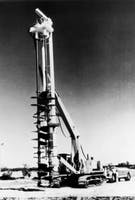Twin, hollow-shaft augers drill into contaminated soils to mix in nutrients that degrade hydrocarbons.
An Arizona company used a new in situ bioremediation technology to clean up 3,600 cu yd of soil contaminated with diesel fuel and waste oil from leaking underground storage tanks.
The Dual Auger soil mixing and bioremediation system injects microorganisms and nutrients into the soil while churning the soil to depths as great as 100 ft. In this manner, the additives biologically degrade contaminants in place.
The process was developed by In-Situ Fixation Inc., Chandler, Ariz.
Process description
According to an In-Situ Fixation press release, "The system greatly increases the efficiency and rate of biodegradation in deeply contaminated soils and reaches areas that might otherwise remain untreated."
No excavation is needed, and there are no significant dust emissions, according to the company.
The system uses twin, 5-ft diameter augers, powered and moved by a back hoe (photo). Special nozzles inject nutrients into the soil through the augers' hollow shafts.
In-Situ Fixation performs on site testing to determine the appropriate nutrient concentration and addition rate. Average treatment costs are $30-50/cu yd.
Cleanup of 3,600 cu yd of petroleum-contaminated soil at the test site (the service area of a Yuma, Ariz., car dealership) took less than 6 months.
Initial site testing showed contamination as high as 35,000 ppm to a depth of 40 ft. After cleanup, diesel concentration was less than 500 ppm and waste oil concentration was less than 6,000 ppm.
These levels easily met the Arizona Department of Environmental Quality's closure requirements, says In-Situ Fixation.
The system also can be used to inject steam to strip volatile organic compounds, or to inject slurry to solidify and stabilize inorganic contaminants.
Copyright 1996 Oil & Gas Journal. All Rights Reserved.


